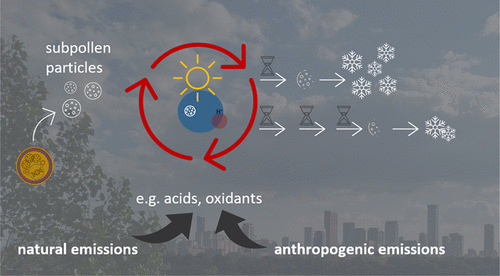当前位置:
X-MOL 学术
›
ACS Earth Space Chem.
›
论文详情
Our official English website, www.x-mol.net, welcomes your
feedback! (Note: you will need to create a separate account there.)
Ice Nucleation Ability of Tree Pollen Altered by Atmospheric Processing
ACS Earth and Space Chemistry ( IF 2.9 ) Pub Date : 2020-11-23 , DOI: 10.1021/acsearthspacechem.0c00218 Ellen Gute 1 , Robert O. David 2 , Zamin A. Kanji 2 , Jonathan P. D. Abbatt 1
ACS Earth and Space Chemistry ( IF 2.9 ) Pub Date : 2020-11-23 , DOI: 10.1021/acsearthspacechem.0c00218 Ellen Gute 1 , Robert O. David 2 , Zamin A. Kanji 2 , Jonathan P. D. Abbatt 1
Affiliation

|
Atmospheric subpollen particles (SPPs) released from pollen grains can act as ice nucleating particles. Using a droplet–freezing approach to assess immersion freezing–ice nucleating (IN) activity, we investigate the effects of simulated atmospheric processing on IN ability in aqueous suspensions for SPPs exposed to (A) light arising from artificial solar radiation and 310 nm UV radiation, (B) acidic water conditions, and (C) oxidation by hydrogen peroxide and a hydroxyl radical. The most studied IN–active SPP, gray alder, loses IN activity upon exposure to all processing modes, with less active IN sites more deactivated relative to their more active counterparts. The two other investigated SPPs, silver birch and red mulberry, are less responsive to atmospheric aging. The most significant impact arose from simulated solar radiation, where a 24 h exposure lowered the IN-activation temperature of gray alder SPPs by up to 5 °C. Similar changes observed after 4 h of exposure to 310 nm light indicate that UV radiation is the most important aging pathway for active-site deactivation. Additionally, we found that water acidity (pH 4–3) negatively impacts the IN activity of all SPPs. Oxidation induced by hydrogen peroxide at high concentrations of 10–500 mM reduced IN activity, consistent with chemical processing altering a specific active-site configuration. Changes in IN activity via aqueous OH radical oxidation were not observable above the effects arising from hydrogen peroxide when present as the OH precursor. Overall, these results imply that the role SPPs play in cloud ice formation may be reduced with longer atmospheric processing times.
中文翻译:

大气加工改变花粉的冰核能力
从花粉粒释放的大气亚花粉颗粒(SPP)可以充当冰核颗粒。使用液滴冷冻方法评估沉浸冰冰成核(IN)活性,我们研究了模拟大气处理对水悬浮液中SPP暴露于(A)人工太阳辐射和310 nm UV辐射产生的IN能力的影响,(B)酸性水条件和(C)被过氧化氢和羟基自由基氧化。研究最多的IN-活性SPP(灰al木)在暴露于所有加工模式后会失去IN活性,活性较低的IN位置相对于活性较高的SPP位置更失活。研究的另外两个SPP,白桦树和桑对大气老化的反应较弱。最重要的影响来自模拟的太阳辐射,暴露24小时使灰al木SPP的IN活化温度降低了5°C。暴露于310 nm光线4 h后观察到的类似变化表明,UV辐射是激活位点失活最重要的老化途径。此外,我们发现水的酸度(pH值为4–3)会对所有SPP的IN活性产生负面影响。过氧化氢在10–500 mM的高浓度下引起的氧化降低了IN活性,这与化学处理改变了特定的活性位点构型是一致的。当以OH前体形式存在时,通过过氧化氢引起的IN活性的变化在由过氧化氢引起的影响之上是不可观察的。总体而言,这些结果表明,随着大气处理时间的延长,SPP在云冰形成中的作用可能会降低。
更新日期:2020-12-17
中文翻译:

大气加工改变花粉的冰核能力
从花粉粒释放的大气亚花粉颗粒(SPP)可以充当冰核颗粒。使用液滴冷冻方法评估沉浸冰冰成核(IN)活性,我们研究了模拟大气处理对水悬浮液中SPP暴露于(A)人工太阳辐射和310 nm UV辐射产生的IN能力的影响,(B)酸性水条件和(C)被过氧化氢和羟基自由基氧化。研究最多的IN-活性SPP(灰al木)在暴露于所有加工模式后会失去IN活性,活性较低的IN位置相对于活性较高的SPP位置更失活。研究的另外两个SPP,白桦树和桑对大气老化的反应较弱。最重要的影响来自模拟的太阳辐射,暴露24小时使灰al木SPP的IN活化温度降低了5°C。暴露于310 nm光线4 h后观察到的类似变化表明,UV辐射是激活位点失活最重要的老化途径。此外,我们发现水的酸度(pH值为4–3)会对所有SPP的IN活性产生负面影响。过氧化氢在10–500 mM的高浓度下引起的氧化降低了IN活性,这与化学处理改变了特定的活性位点构型是一致的。当以OH前体形式存在时,通过过氧化氢引起的IN活性的变化在由过氧化氢引起的影响之上是不可观察的。总体而言,这些结果表明,随着大气处理时间的延长,SPP在云冰形成中的作用可能会降低。











































 京公网安备 11010802027423号
京公网安备 11010802027423号